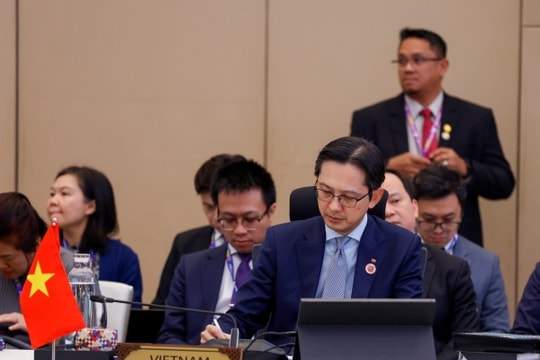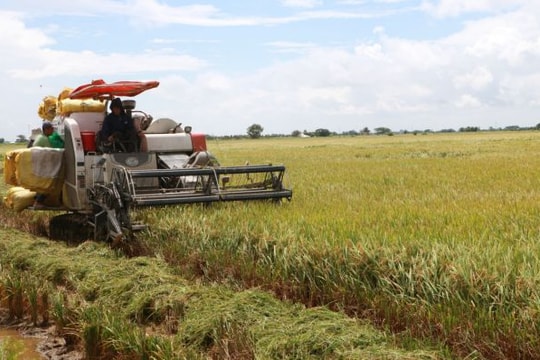
Over the years, the ASEAN market has always played a crucial role in Vietnamese import and export activities. This is consistent with the efforts to strengthen trade promotion and boost market expansion as a means of ensuring the goal of increasing export turnover of ministries, sectors, trade agencies, as well as the business community.
Information released by the Department of Asian - African Markets under the Ministry of Industry and Trade (MoIT) indicates that most goods exported to the ASEAN market enjoy preferential tariffs of 0%, according to the ASEAN Trade in Goods Agreement (ATIGA). Alternatively, they enjoy more special incentives according to bilateral trade agreements (FTAs) and agreements of each country, such as the Vietnam - Laos Trade Agreement and the Vietnam - Cambodia Bilateral Trade Promotion Agreement.
Over the past seven months alone, the nation ranked as Singapore's 12th largest trading partner, with two-way trade turnover of more than SGD18.32 billion, up 9.02% over the same period. Of these, exports increased sharply by 27.03%, reaching more than SGD4.7 billion and imports were more than SGD13.61 billion, up 3.93%.
A representative of the Vietnam Trade Office in Singapore said that three major Vietnamese export groups to Singapore continued to see spikes, specifically machinery, equipment, mobile phones, components and spare parts of all kinds; boilers, machine tools and spare parts; as well as glass and glass products.
“Some other export industries also recorded strong growth, such as iron and steel; optical machines, measuring instruments, medical equipment, watches, musical instruments and accessories of all kinds. Notably, Vietnam is currently the country with the largest market share in Singapore for three groups of rice,” the Trade Office said.
To clarify this information, Cao Xuan Thang, trade counselor and head of the Vietnam Trade Office in Singapore, said that Singapore's rice market has a stable demand of SDG300 to SDGG400 million per year. Vietnamese enterprises have therefore taken advantage of this to increase their market share and export value to the city state.
“In addition to the attention of industry associations and enterprises in trade promotion and taking advantage of opportunities, the business support activities of the Trade Office of the Vietnamese Embassy in Singapore, along with the close direction of ministries and localities, have contributed to promoting the growth of rice export turnover to the Singapore market,” Thang commented.
However, Thang also frankly pointed out that the promotion and introduction of Vietnamese rice products in the Singapore market remains modest. Trade promotion activities and the display of rice products in the city state are regularly implemented by the Vietnam Trade Office.
“To better support Vietnamese enterprises in the coming time, the Vietnam Trade Office in Singapore will continue to update the situation, mechanisms and policies of the host nation. The office will support Vietnamese enterprises in connecting trade, displaying goods, promoting Vietnamese enterprise brands and product brands in order to increase the presence of Vietnamese goods and support the export of goods to the Singapore market,” Thang affirmed.
Taking advantage of favourable conditions
The Philippines' annual rice imports are always high. Phung Van Thanh, trade counselor of the Vietnam Trade Office in the Philippines, said that the Philippines is a large rice consumer and is one of the world's leading rice importers.
This forecasts that the Philippines' total rice imports this year are likely to reach more than four million tonnes, even up to 4.5 million tonnes.
“This is a great opportunity for Vietnamese rice exporting enterprises to boost exports to this market. Over the past half of 2024, the Philippines imported 1.72 million tons of rice from Vietnam,” Thanh said.
In addition to Singapore and the Philippines, in 2023 Indonesia rose to become the second largest Vietnamese rice importer with an output of more than 1.1 million tonnes, earning more than US$640 million, a sharp increase of 878% in volume and 992% in value compared to 2022.
Since the beginning of the year, due to a serious rice shortage, the Indonesian Government has opened a bid to purchase an additional 500,000 tonnes of rice. Vietnamese rice exporting enterprises have won the bid in this round, supplying more than 300,000 tonnes of rice to Indonesia. Therefore, the Vietnam Trade Office in Indonesia recommends that local rice exporters need to closely monitor market information and capitalize on opportunities for further rice exports to the Indonesian market in the following years.
With commitments to open up the market, large tax incentives, similarities in geographical location, culture, favourable conditions have been created for Vietnamese enterprises to export goods to the ASEAN market.
Assessing the potential of the ASEAN market, Nguyen Thi Thu Trang, director of the WTO and Integration Centre, Vietnam Chamber of Commerce and Industry (VCCI), said that one of the advantages for ASEAN enterprises in general and Vietnamese enterprises in particular when participating in trade agreements is that they will be given priority when applying preferential tax rates in exporting goods.
Intra-ASEAN trade will thus be freer, safer, and more beneficial to businesses in the region.





































